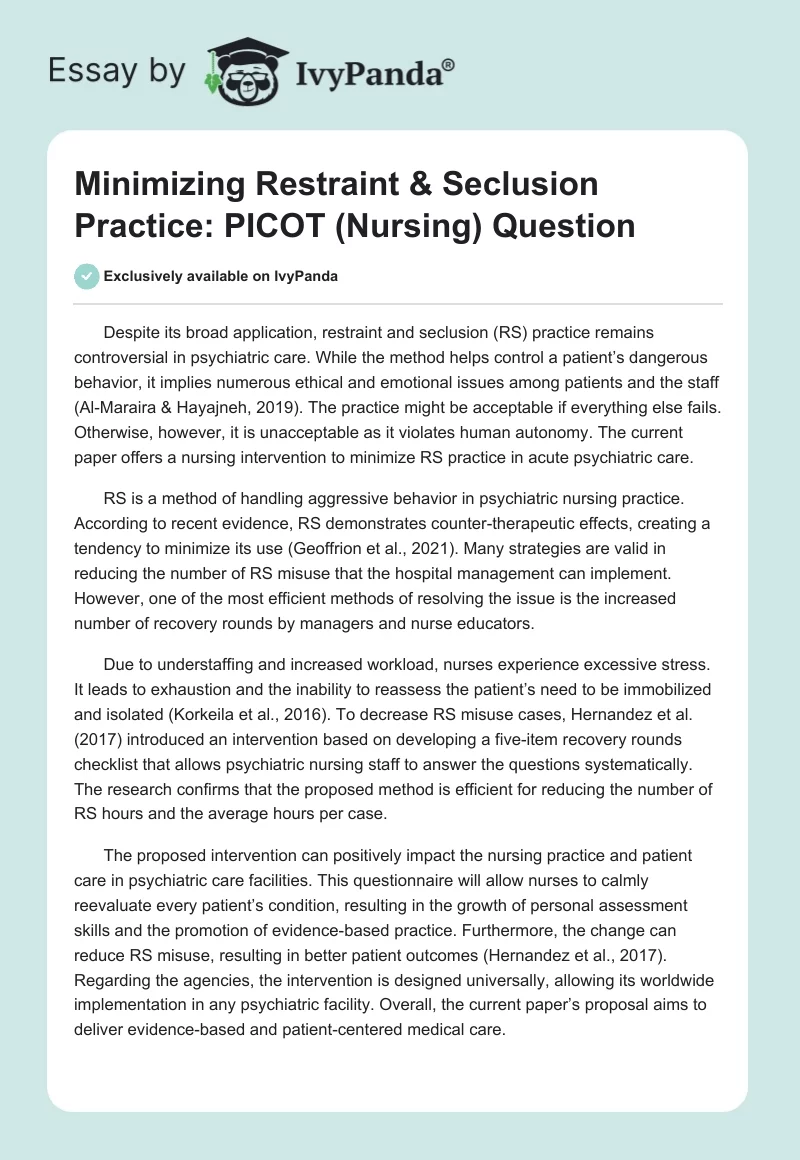Despite its broad application, restraint and seclusion (RS) practice remains controversial in psychiatric care. While the method helps control a patient’s dangerous behavior, it implies numerous ethical and emotional issues among patients and the staff (Al-Maraira & Hayajneh, 2019). The practice might be acceptable if everything else fails. Otherwise, however, it is unacceptable as it violates human autonomy. The current paper offers a nursing intervention to minimize RS practice in acute psychiatric care.
RS is a method of handling aggressive behavior in psychiatric nursing practice. According to recent evidence, RS demonstrates counter-therapeutic effects, creating a tendency to minimize its use (Geoffrion et al., 2021). Many strategies are valid in reducing the number of RS misuse that the hospital management can implement. However, one of the most efficient methods of resolving the issue is the increased number of recovery rounds by managers and nurse educators.
Due to understaffing and increased workload, nurses experience excessive stress. It leads to exhaustion and the inability to reassess the patient’s need to be immobilized and isolated (Korkeila et al., 2016). To decrease RS misuse cases, Hernandez et al. (2017) introduced an intervention based on developing a five-item recovery rounds checklist that allows psychiatric nursing staff to answer the questions systematically. The research confirms that the proposed method is efficient for reducing the number of RS hours and the average hours per case.
The proposed intervention can positively impact the nursing practice and patient care in psychiatric care facilities. This questionnaire will allow nurses to calmly reevaluate every patient’s condition, resulting in the growth of personal assessment skills and the promotion of evidence-based practice. Furthermore, the change can reduce RS misuse, resulting in better patient outcomes (Hernandez et al., 2017). Regarding the agencies, the intervention is designed universally, allowing its worldwide implementation in any psychiatric facility. Overall, the current paper’s proposal aims to deliver evidence-based and patient-centered medical care.
The PICO (T) Question
The Population, Intervention, Comparison, Outcome, and Time (PICOT) question for this paper is: In the adult population in psychiatric care (P), how does the introduction of daily RS questionnaire (I) compare to units without the daily survey (C) impact the number of RS utilization (O) in a 6-months framework (T)?
References
Al-Maraira, O. A., & Hayajneh, F. A. (2019). Use of restraint and seclusion in psychiatric settings: A literature review. Journal of Psychosocial Nursing and Mental Health Services, 57(4), 32-39. Web.
Geoffrion, S., Lamothe, J., Fraser, S., Lafortune, D., & Dumais, A. (2021). Worker and perceived team climate factors influence the use of restraint and seclusion in youth residential treatment centers: Results from a mixed-method longitudinal study. Child Abuse & Neglect, 111, 104825. Web.
Hernandez, A., Riahi, S., Stuckey, M., Mildon, B., & Klassen, P. (2017). A multidimensional approach to restraint minimization: The journey of a specialized mental health organization. International Journal of Mental Health Nursing, 26(5), 482-490. Web.
Korkeila, H., Koivisto, A., Paavilainen, E., & Kylmä, J. (2016). Psychiatric nurses’ emotional and ethical experiences regarding seclusion and restraint. Issues in Mental Health Nursing, 37(7), 464-475. Web.


